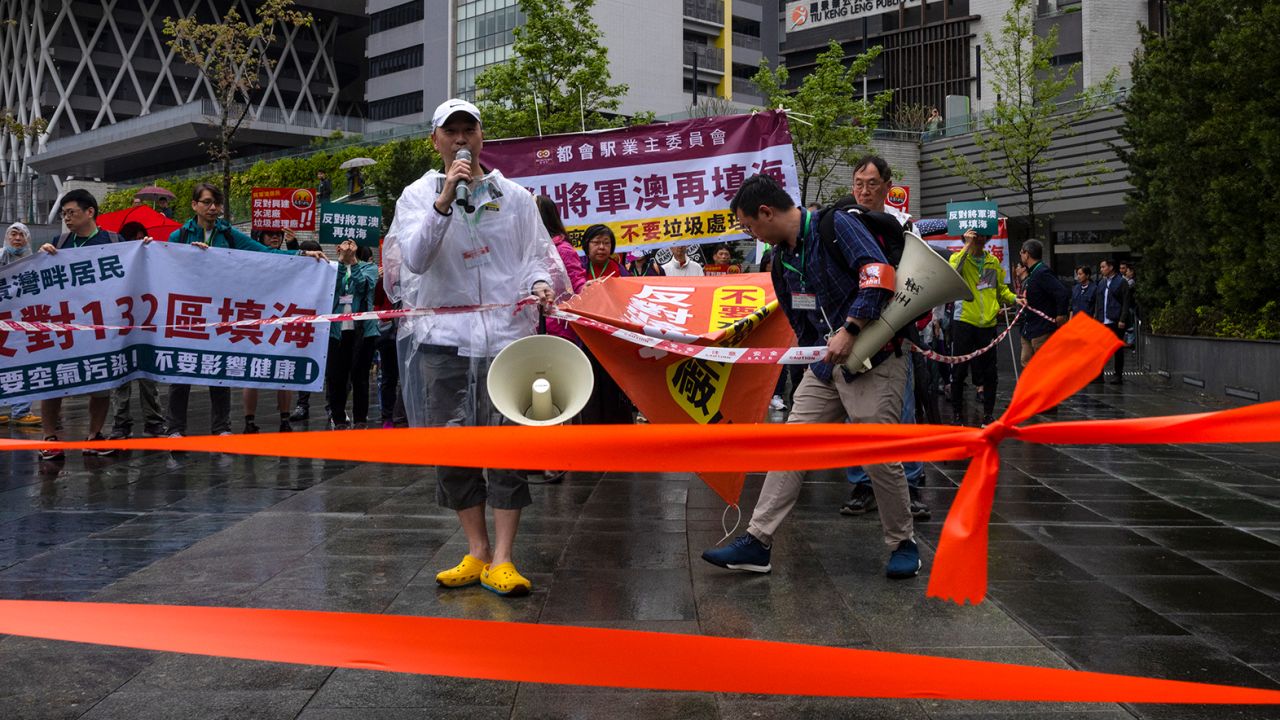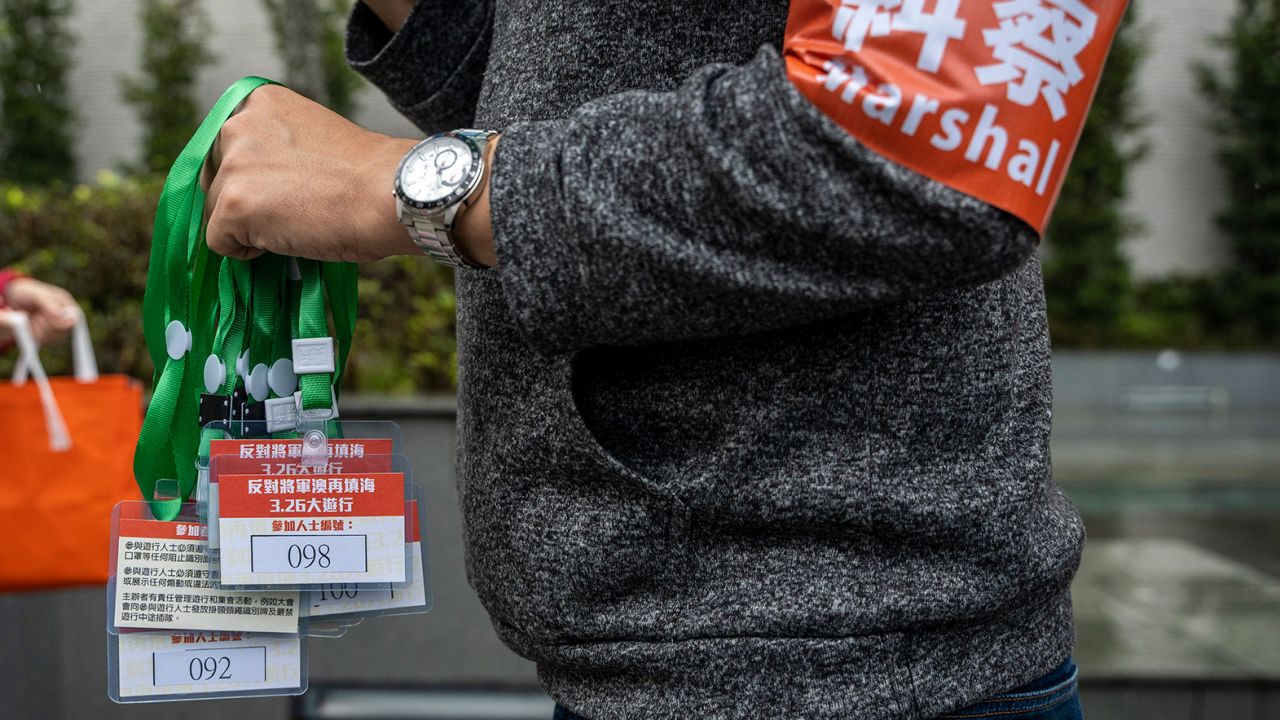Hong-Kong
CNN
—
Carrying numbered lanyards, a small group of 80 protesters took part in Hong Kong’s first authorized protest in three years on Sunday — a carefully choreographed event that campaigners say offers a chilling insight into the future of protest in the city.
The number was capped at 100, and during the hour-long event organizers repeatedly told journalists to stay away from them after warnings from police that the presence of the press could lead to the march being cancelled.
The protest was a far cry from massive democracy demonstrations of just a few years ago, when hundreds of thousands of Hong Kongers rallied against what they saw as Beijing tightening its control over the city, some clashing with police.
Sunday’s protesters were not calling for democracy, but demolition of a local reclamation project in Tseung Kwan O they said would increase pollution in their middle-class neighborhood – but strict conditions were applied.
Cyrus Chan, one of the organizers of Concern Group For Tseung Kwan O People’s Livelihood, said police had screened the protest’s publicity materials and told organizers not to advise participants to dress in yellow and black – colors associated with with the city’s pro-democracy movement and mass protests. protests in 2019.
“There should be no posts that are considered politically sensitive, inflammatory and of sensitive colors,” Chan recalled.
A Hong Kong Police spokesperson said the arrangements were made based on their risk assessments of the purpose, nature, number of participants, past experience and the organizers’ latest circumstances.
Figo Chan, former chairman of the now-disbanded Civil Human Rights Front group, which once brought huge crowds of pro-democracy supporters to the streets of Hong Kong, said Sunday’s event showed how difficult it can be for activists to express their views. make in the city.
“This is the new era with Hong Kong characteristics,” Chan described, borrowing the term from the Chinese Communist Party to first describe its socialist-capitalist philosophy, which has since expanded to include its “democracy with Chinese characteristics.”
“I think it will be very difficult to hold a protest in the future,” Chan said.

‘I want fresh air. No reclamation work,” the crowd chanted as they marched a short distance from a train station to Tseung Kwan O Waterfront Park, near the site of the proposed project that includes the construction of a concrete plant and waste station.
About 40 police officers – about half the number of demonstrators – were deployed to ensure that the rules were followed.
Winnie Chiu, who held the number plate 10, kept her distance from politics during the protest. “This is not a political demand. This is about basic daily life and our health,” said the 50-something teacher.
It was a small event, but very important to campaigners in a city where protests have largely fallen silent.
The last time Hong Kongers took to the streets in large numbers was in 2019 and 2020, when protests against an extradition bill turned into wider calls for democracy.
For many, the extradition bill meant a tightening of China’s control over the semi-autonomous city, which had been governed under a “one country, two systems” policy for 50 years after the handover from British to Chinese rule in 1997.
As the number of protests grew, the government’s stance hardened and police responded with tear gas and rubber bullets.
The protests ended after restrictions on gatherings due to Covid and Beijing’s introduction of the national security law in June 2020, which threatened arrest for anyone suspected of “secession, subversion, terrorism and collusion with foreign forces.”
Hong Kong police have also cited the pandemic as a reason for rejecting protest requests for the past three years.
Earlier this month, the Hong Kong Women Workers’ Association planned a demonstration in support of International Women’s Day but canceled it despite police approval and declined to comment.
After the national security law was introduced, many opposition figures responsible for organizing the protests were arrested without bail and many civilian agencies were forced to close, including Figo Chan’s Civil Human Rights Front.
The local activist said he does not view Sunday’s Tseung Kwan O protest as a proper public gathering, guaranteed by the city’s mini-constitution, the Basic Law.
“There’s an imposed quota of 100, so it’s just a protest from a small group, not the public,” he said.
Chan said in the past that police would ask his group for estimated numbers, but imposing a quota defeated the purpose of a protest, which should be open to all.

Another activist Raphael Wong, of the League of Social Democrats, said he believed the tight controls reflect authorities’ fears.
“There will be no easing until Hong Kong and Chinese officials feel less tense about the situation,” he said.
Law scholar Michael Davis, who taught human rights law at the University of Hong Kong, called the arrangement “a disgrace” and stressed that Sunday’s protesters posed no threat to the government in any way.
The global fellow of the Woodrow Wilson International Center for Scholars, a think tank in Washington DC, compared the situation to that of Singapore, where protesters can only address crowds without a permit at “Speaker’s Corner”, making demonstrations very rare.
“These restrictions leave little or no room for a civil rights movement,” he said.
However, pro-Beijing lawmaker Regina Ip, who served as the city’s security minister between 1998 and 2003, defended the police, saying the right to protest is not absolute. She cited the 2019 skirmishes as justification for stricter measures.
Asked if there is scope for the police to scale back their measures in the future, Ip said they should “assess the situation depending on the circumstances at the time”.
Cyrus Chan, who organized it Sunday’s march said it hoped the orderly display would open the door for other protests.
“I hope we have shown the governments of Hong Kong and China, as well as the local police, that the people of Hong Kong can protest in a rational and peaceful manner without any restrictions,” he said.
CORRECTION: An earlier version of this story incorrectly claimed that the 2019 protests violated Hong Kong’s security law. The security law was introduced a year later.